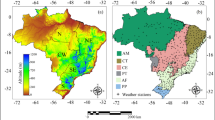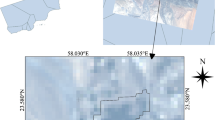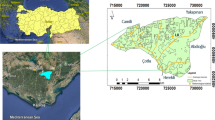Abstract
This paper aimed to support the rational crop expansion in agricultural-growing regions. MODIS satellite images are used together with gridded weather data to model biometeorological parameters at the Fruit Circuit region, state of São Paulo, Southeast Brazil. This region has experienced some cases of drought, while arising rainfall water excess in some periods, demanding large-scale water and energy balance studies to subsidize water resource policies. The SAFER (Simple Algorithm for Evapotranspiration Retrieving) algorithm was applied together with the radiation-use efficiency (RUE) model for biometeorological index assessments. The highest latent heat fluxes (λE), above 8.0 MJ m−2 d−1, at the end of the year, coincide with the progressive increases on both rainfall and global solar radiation (RG) levels, and drop to below 5.0 MJ m−2 d−1 in the middle of the year, during the driest conditions. The same tendencies along the year are verified for sensible heat fluxes (H), for which mean pixel values are above 3.5 MJ m−2 d−1 at the end of the year. On the one hand, the highest values for water productivity (WP), which is considered the ratio of actual evapotranspiration (ET) to biomass production (BIO), above 4.0 kg m−3, are verified in April, period under increasing BIO and low ET rates. On the other hand, the lowest WP values (below 2.0 kg m−3) occur between August and October, when BIO is low, and ET is high. Although the area featuring good WP levels under high precipitation (P), with rainfalls generally above ET, supplementary irrigation may benefit agriculture in some periods of the year. The results of the large-scale modeling showed applicability of the models for monitoring water and vegetation dynamics over 16-day timescale and at a 250-m spatial resolution in areas experiencing climate and land-use changes by combining climate data and MODIS images. Application of these tools enables to indicate the best options for expanding the agriculture activities, being of great potential for rational natural resources management, in regions under environmental vulnerability conditions.








Similar content being viewed by others
References
Adak T, Kumar G, Chakravarty NVK, Katiyar RK, Deshmukh PS (2013) Biomass and biomass water use efficiency in oilseed crop (Brassica. junceae. L.) under semi-arid microenvironments. Biomass Bioenergy 51:154–162
Allen RG, Tasumi M, Morse A, Trezza R, Wright JL, Bastiaanssen W, Kramber W, Lorite I, Robison CW (2007) Satellite-based energy balance for mapping evapotranspiration with internalized calibration (METRIC) - applications. J Irrig Drain Eng 133:395–406
Anderson-Teixeira KJ, Snyder PK, Twine TE, Cuadra SV, Costa MH, DeLucia EH (2012) Climate-regulation services of natural and agricultural ecoregions of the Americas. Nat Clim Chang 2:177–181
Araujo LM, Teixeira AH d C, Bassoi LH (2019) Evapotranspiration and biomass modelling in the Pontal Sul Irrigation Scheme. Int J Remote Sens 1:1–13
Bardin-Camparotto L, Pedro Junior MJ, Blain GC et al (2013) Polo turístico do Circuito das Frutas do estado de São Paulo: Fisiografia e clima. Boletim técnico. Instituto Agronômico de Campinas-IAC, Campinas
Bastiaanssen WGM, Ali S (2003) A new crop yield forecasting model based on satellite measurements applied across the Indus Basin, Pakistan. Agric Ecosyst Environ 94:321–340
Beguería S, Vicente-Serrano SM, Reig F, Latorre B (2014) Standardized precipitation evapotranspiration index (SPEI) revisited: parameter fitting, evapotranspiration models, tools, datasets and drought monitoring. Int J Climatol 34:3001–3023
Bento VA, Gouveia CM, DaCamaraa CC, Trigo IF (2018) A climatological assessment of drought impact on vegetation health index. Agric For Meteorol 259:286–295
Beringer T, Lucht W, Schaphoff S (2011) Bioenergy production potential of global biomass plantations under environmental and agricultural constraints. GCB Bioenergy 3:299312
Bhattarai N, Wagle P, Gowda PH, Kakani VG (2017) Utility of remote sensing-based surface energy balance models to track water stress in rain-fed switchgrass under dry and wet conditions. ISPRS J Photogramm Remote Sens 113:128–141
Bispo RC, Hernandez FBT, Teixeira AH d C (2017) Balanço hídrico e estimativa do consumo relativo de água na cultura de cana-de-açúcar na região noroeste paulista. Irriga 1:94–101
Castelli M, Asam S, Jacob A, Zebisch M, Notarnicola C (2018) Monitoring daily evapotranspiration in the Alps exploiting Sentinel-2 and meteorological data. Remote Sensing & Hydrology Symposium. (ICRS-IAHS)
Cerri CC, Galdos MV, Maia SMF, Bernoux M, Feigl BJ, Powlson D, Cerri CEP (2011) Effect of sugarcane harvesting systems on soil carbon stocks in Brazil: an examination of existing data. Eur J Soil Sci 62:23–28
Ceschia E, Beziat P, Dejoux JF, Aubinet M, Bernhofer C, Bodson B et al (2010) Management effects on net ecosystem carbon and GHG budgets at European crop sites. Agric Ecosyst Environ 139:363–383
Claverie M, Demarez V, Duchemin B, Hagolle O, Ducrot D, Marais-Sicre C et al (2012) Maize and sunflower biomass estimation in Southwest France using spatial and temporal resolution remote sensing data. Remote Sens Environ 124:884–857
Coaguila DN, Hernandez FBT, Teixeira AH d C et al (2017) Water productivity using SAFER - Simple Algorithm for Evapotranspiration Retrieving in watershed. Rev Bras Eng Agr Amb 21:524–529
Feitosa DG, Hernandez FBT, Franco RAM, Teixeira AH de C, Neale CMU (2016) Energy balance in the watershed of Ipê, Northwestern São Paulo State, Brazil. Proc SPIE 9998: 99980O-1- 99980O-11
Fernandes EX, Nery JT (2015) Energy balance in the cerrado of ecological station of Assis – Assis, São Paulo State, Brazil. Acta Sci 37:411–415
Franco RAM, Hernandez FBT, Teixeira AH de C (2014) Water productivity of different land uses in watersheds assessed from satellite imagery Landsat 5 Thematic Mapper. Proc SPIE 9239: 92392E-1-92392E-7
Franco RAM, Hernandez FBT, Teixeira AH de C, Leivas JF, Nuñez DNC, Neale CMU (2016) Water productivity mapping using Landsat 8 satellite together with weather stations. Proc SPIE: 9998: 99981H-1-99981H-12
Gouveia C, Trigo RM, Beguería S, Vicente-Serrano SM (2017) Drought impacts on vegetation activity in the Mediterranean region: an assessment using remote sensing data and multi-scale drought indicators. Glob Planet Chang 151:15–27
Hernandez FBT, Teixeira AH d C, Neale CMU, Taghvaeian S (2014) Determining large scale actual evapotranspiration using agro-meteorological and remote sensing data in the northwest of Sao Paulo state, Brazil. Acta Hortic 1038:263–270
Kim D, Rhee J (2016) A drought index based on actual evapotranspiration from the Bouchet hypothesis. Geophys Res Lett 43:10277–10285
Mateos L, González-Dugo MP, Testi L, Villalobos FJ (2013) Monitoring evapotranspiration of irrigated crops using crop coefficients derived from time series of satellite images I. Method validation. Agric Water Manag 125:81–91
Mokhtari A, Noory H, Pourshakouri F, Haghighatmehr P, Afrasiabian Y, Razavi M, Fereydooni F, Sadeghi Naeni A (2019) Calculating potential evapotranspiration and single crop coefficient based on energy balance equation using Landsat 8 and Sentinel-2. ISPRS J Photogramm Remote Sens 154:231–245
Monteith JL (1977) Climate and efficiency of crop production in Britain. Philos Trans R Soc B 281:277–294
Mu Q, Zhao M, Running SW (2011) Improvements to a MODIS global terrestrial evapotranspiration algorithm. Remote Sens Environ 115:1781–1800
Mueller N, Lewis A, Roberts D, Ring S, Melrose R, Sixsmith J, Lymburner L, McIntyre A, Tan P, Curnow S, Ip A (2016) Water observations from space: mapping surface water from 25 years of Landsat imagery across Australia. Remote Sens Environ 174:341–352
Nyolei D, Nsaali M, Minaya V, van Griensven A, Mbilinyi B, Diels J, Hessels T, Kahimba F (2019) High resolution mapping of agricultural water productivity using SEBAL in a cultivated African catchment, Tanzania. Phys Chem Earth 112:36–39
Ramírez-Cuesta JM, Vanella D, Consoli S, Motisi A, Minacapilli M (2018) A satellite stand-alone procedure for deriving net radiation by using SEVIRI and MODIS products Int. J Appl Earth Obs Geoinformation 73:786–799
Ramírez-Cuesta JM, Allen RG, Zarco-Tejada PJ, Kilic A, Santos C, Lorite IJ (2019) Impact of the spatial resolution on the energy balance components on an open-canopy olive orchard. Int J Appl Earth Obs Geoinf 74:88–102
Rozenstein O, Haymann N, Kaplan G, Tanny J (2018) Estimating cotton water consumption using a time series of Sentinel-2 imagery. Agric Water Manag 207:44–52
Santos JEO, Cunha FF, Filgueiras R, Silva GH, Teixeira AH d C, Silva FCS, Sediyama GC (2020) Performance of SAFER evapotranspiration using missing meteorological data. Agric Water Manag 233:1–8
Senay GB, Schauer M, Friedrichs M, Velpuri NM, Singh RK (2017) Satellite-based water use dynamics using historical Landsat data (1984–2014) in the southwestern United States. Remote Sens Environ 202:98–112
Silva COF, Manzione RL, Teixeira AH d C (2018a) Modelagem espacial da evapotranspiração e produtividade hídrica na porção paulista do afloramento do aquífero Guarani entre 2013 e 2015. Holos Environt 18:126–140
Silva COF, Manzione RL, Filho JLA (2018b) Large-scale spatial modeling of crop coefficient and biomass production in agroecosystems in southeast Brazil. Horticulturae 4:1–20
Silva COF, Teixeira AH d C, Manzione RL (2019) Agriwater: an R package for spatial modelling of energy balance and actual evapotranspiration using satellite images and agrometeorological data. Environ Model Softw 120:1–19
Silva Junior JF, Hernandez FBT, SILVA IPF et al (2018) Estabelecimento dos meses mais críticos para a agricultura irrigada a partir do estudo do balanço hídrico. Rev Bras Eng Biossist 12:122–131
Teixeira AH d C (2010) Determining regional actual evapotranspiration of irrigated and natural vegetation in the São Francisco river basin (Brazil) using remote sensing and Penman-Monteith equation. Remote Sens 2:1287–1319
Teixeira AH d C, Bastiaanssen WGM, Ahmad MD et al (2008) Analysis of energy fluxes and vegetation-atmosphere parameters in irrigated and natural ecosystems of semi-arid Brazil. J Hydrol 362(110–127):2008
Teixeira AH d C, Leivas JF, Ronquim CC, Victoria D d C (2016) Sugarcane water productivity assessments in the São Paulo state, Brazil. Int J Remote Sens Appl 6:84–95
Teixeira AH de C, Leivas JF, Ronquim CC, Bayma-Silva, G (2017a) he use of MODIS images to quantify the energy balance in different agroecosystems in Brazil. In: Multi-purposeful application of geospatial data, vol 1, 1st edn. Intech, London, pp 105–121
Teixeira AH d C, Leivas JF, Hernandez FBT, Franco RAM (2017b) Large-scale radiation and energy balances with Landsat 8 images and agrometeorological data in the Brazilian semiarid region. J Appl Remote Sens 1:016030–11-016030-15
Teixeira AH de C, Leivas JF, Bayma-Silva G (2017c) Drought assessments by coupling moderate resolution imaging spetroradiometer images and weather data: a case study in the Minas Gerais state, Brazil. In: Remote sensing of hydrometeorological hazards, 1st edn. Taylor & Francis, Boca Raton-FL, pp 53–68
Teixeira AH d C, Leivas JF, Silva GB, Garçon EAM (2018a) Evapotranspiration estimations in the Brazilian semi-arid by using MODIS reflectance products and Agrometeorological stations. Modern Environ Sci Engr 4:562–569
Teixeira AH de C, Simão FR, Leivas JF et al. (2018b) Water productivity modeling by remote sensing in the semiarid region of Minas Gerais state, Brazil in: Arid environments and sustainability. London: In Tech, v.1, p. 94–108
Teixeira AH d C, de Miranda FR, Leivas JF et al (2019) Water productivity assessments for dwarf coconut by using Landsat 8 images and agrometeorological data. ISPRS J Photogramm Remote Sens 55:150–158
Tulbure MG, Broich M, Stehman SV, Kommareddy A (2016) Surface water extent dynamics from three decades of seasonally continuous Landsat time series at subcontinental scale in a semi-arid region. Remote Sens Environ 178:142–157
Vanino AS, Ninoa P, Micheleb C et al (2018) Capability of Sentinel-2 data for estimating maximum evapotranspiration and irrigation requirements for tomato crop in Central Italy. Remote Sens Environ 215:452–470
Vicente-Serrano SM, Beguería S, Lopez-Moreno JI (2010) A multiscalar drought index sensitive to global warming: the standardized precipitation evapotranspiration index. J Clim 23:1696–1718
Vicente-Serrano SM, Cabello D, Tomás-Burguera M, Martín-Hernández N, Beguería S, Azorin-Molina C, Kenawy A (2015) Drought variability and land degradation in semiarid regions: assessment using remote sensing data and drought indices (1982-2011). Remote Sens 7:4391–4423
Vicente-Serrano SM, Miralles DG, Domínguez-Castrom F et al (2018) Global assessment of the standardized evapotranspiration deficit index (SEDI) for drought analysis and monitoring. J Clim 31:5371–5393
Yan HM, Fu YL, Xiao XM, Huang HQ, He H, Ediger L (2009) Modeling gross primary productivity for winter wheat-maize double cropping system using MODIS time series and CO2 eddy flux tower data. Agric Ecosyst Environ 129:391–400
Yang HB, Qi J, Xu XY, Yang D, Lv H (2014) The regional variation in climate elasticity and climate contribution to runoff across China. J Hydrol 517:607–616
Yang Y, Guan H, Batelaan O et al (2016) Contrasting responses of water use efficiency to drought across global terrestrial ecosystems. Sci Rep 6:1–8
Yao Y, Liang S, Qin Q, Wang K (2010) Monitoring drought over the conterminous United States using MODIS and NCEP Reanalysis-2 data. J Appl Meteorol Climatol 49:1665–1680
Zhang X, Zhang B (2019) The responses of natural vegetation dynamics to drought during the growing season across China. J Hydrol 574:706–714
Zhang L, Qiao N, Huang C, Wang S (2019) Monitoring drought effects on vegetation productivity using satellite solar-induced chlorophyll fluorescence. Remote Sens 11(378):1–18
Zhao M, Heinsch FA, Nemani RR, Running SW (2005) Improving of the MODIS terrestrial gross and net primary production global dataset. Remote Sens Environ 95:164–176
Zhao M, Running SW (2010) Drought-induced reduction in global terrestrial net primary production from 2000 through 2009. Science 329:940–943
Acknowledgments
We acknowledge the Brazilian National Meteorological Institute (INMET) for making the weather data available.
Funding
The authors received financial support for projects dealing with large-scale energy and water balance analyses from the Brazilian National Research Council (CNPq).
Author information
Authors and Affiliations
Contributions
AH de C. Teixeira - The first author was responsible for running the models to acquire the large-scale biometeorological indices, writing the manuscript, for the visualization of figures, analyses’ results, software resources, for supervision, project administration, and funding acquisition.
Janice Freitas Leivas - The second author oversaw the running of scripts, downloading MODIS images, formatting of weather data for reference evapotranspiration calculations, and the methodology, data curation, and investigation.
EAM Garçon - Collaborated with image downloads, software running, and visualization of the fig.
CM Takemura - Collaborated with image downloads, software running, and visualization of the fig.
CF Quartaroli - Review, validation, and editing of the manuscript, and analyses’ results.
IA Alvarez - Review, validation, and editing of the manuscript, and analyses’ results.
Corresponding author
Ethics declarations
Conflict of interest
The authors declare that they have no conflict of interest.
Additional information
Publisher’s note
Springer Nature remains neutral with regard to jurisdictional claims in published maps and institutional affiliations.
Rights and permissions
About this article
Cite this article
de Castro Teixeira, A.H., Leivas, J.F., Garçon, E.A.M. et al. Modeling large-scale biometeorological indices to monitor agricultural-growing areas: applications in the fruit circuit region, São Paulo, Brazil. Int J Biometeorol 64, 2053–2064 (2020). https://doi.org/10.1007/s00484-020-01996-9
Received:
Revised:
Accepted:
Published:
Issue Date:
DOI: https://doi.org/10.1007/s00484-020-01996-9




